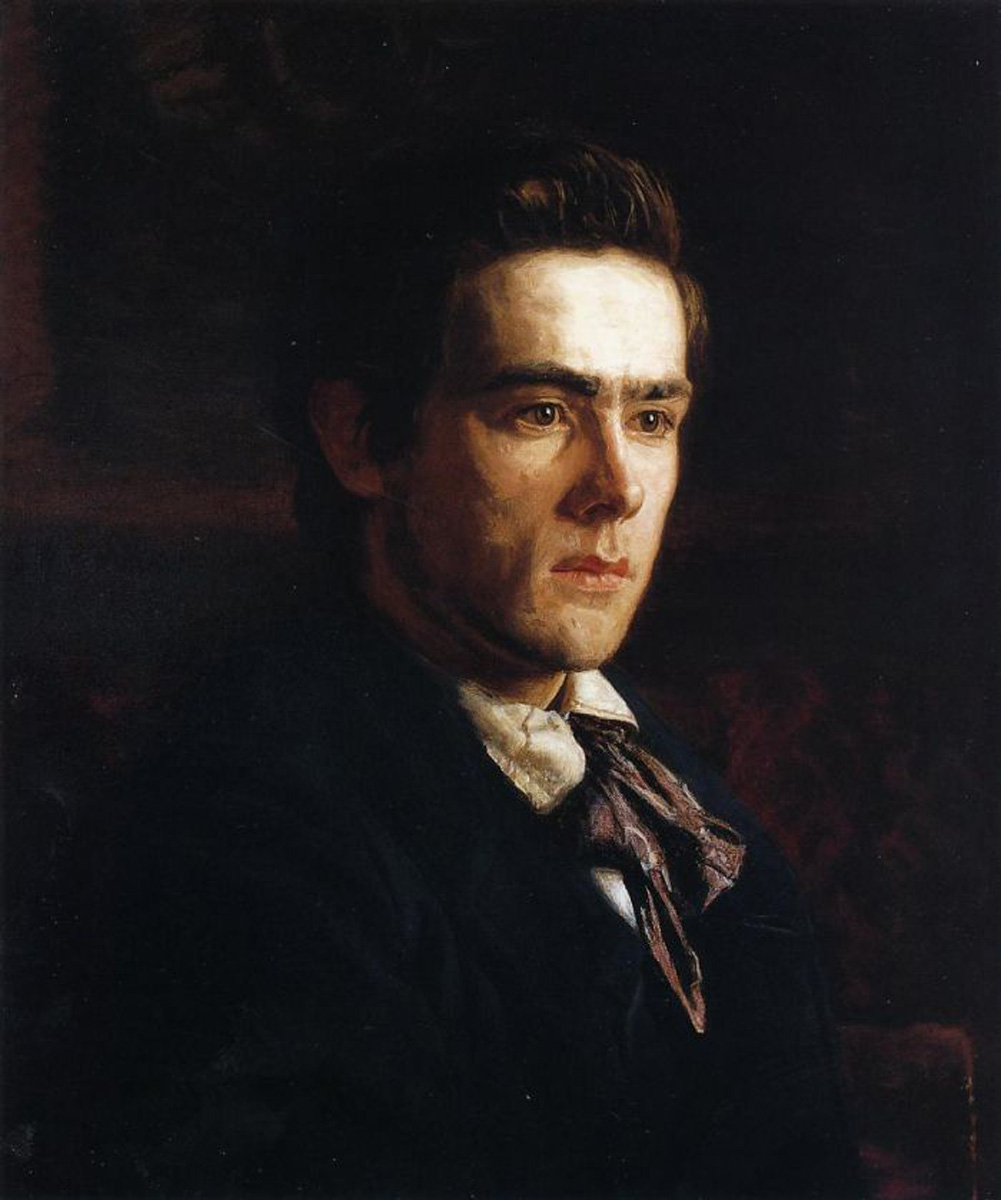

Partner Thomas Eakins
Queer Places:
Old Cathedral Cemetery, 1032 N 48th St, Philadelphia, PA 19131
 Samuel
Aloysius Murray (1869 – November 3, 1941) was an American sculptor, educator,
and protégé of the painter
Thomas Eakins. In the latter years of his life, Eakins' constant companion was the
handsome sculptor Samuel Murray, who shared his interest in boxing and
bicycling. The evidence suggests the relationship was more emotionally
important to Eakins than that with his wife.[85]
Scholars have long assumed that the relationship between Eakins and Murray was
as deeply romantic as it was professional (together in 1892, they had modeled
the death mask of Walt Whitman,
across the river in Camden).
Samuel
Aloysius Murray (1869 – November 3, 1941) was an American sculptor, educator,
and protégé of the painter
Thomas Eakins. In the latter years of his life, Eakins' constant companion was the
handsome sculptor Samuel Murray, who shared his interest in boxing and
bicycling. The evidence suggests the relationship was more emotionally
important to Eakins than that with his wife.[85]
Scholars have long assumed that the relationship between Eakins and Murray was
as deeply romantic as it was professional (together in 1892, they had modeled
the death mask of Walt Whitman,
across the river in Camden).
Murray, the 11th of 12 children of an Irish stone cutter and his wife, was born in Philadelphia, Pennsylvania, and educated in the city's parochial schools. In September 1886, at age 17, he entered the seven-month-old Art Students' League of Philadelphia, where he studied under Eakins.[1] He soon became a favored student, then Eakins's assistant, and was listed as an instructor in 1892.[2] The two artists shared a studio at 1330 Chestnut Street from 1892 to about 1900, sometimes painting and sculpting from the same model.
The pair spent a great deal of time together: working side by side, bicycling around Philadelphia, attending boxing matches, fishing in Gloucester, New Jersey, and taking trips and vacations together. Murray accompanied Eakins on visits to Walt Whitman in Camden, New Jersey (across the Delaware River from Philadelphia), and, following the poet's death on March 26, 1892, they cast a plaster death mask of his face.[3] Murray introduced Eakins to Catholic priests at St. Charles Borromeo Seminary, and Eakins painted portraits of a number of them.
Eakins painted an 1889 portrait of Murray, and featured him in a number of paintings and photographs. Murray modeled at least three figures of Eakins. The exact nature of their relationship is the subject of speculation, but Murray remained a lifelong friend to Eakins, and helped care for the disabled painter in his old age.
At age 21 (reportedly, on Eakins's recommendation), Murray was hired by the Philadelphia School of Design for Women (now Moore College of Art) as an instructor in modeling from life and a lecturer in anatomy—a position he held for over 50 years. Among his students were Edythe Ferris, Bessie Pease Gutmann, Alice Neel, Anne Parrish, Ella Peacock, and most of the Philadelphia Ten.
Murray's career as a sculptor had a propitious beginning: in March 1896, the Pennsylvania Academy of the Fine Arts mounted a solo exhibition of his work. (He was age 27.)[6] His first major commission came in September 1896, for ten colossal terracotta statues of Biblical prophets to adorn the facade of Philadelphia's Witherspoon Building.[7] Eakins is rumored to have assisted on the project, and at least six of the figures were modeled on members of their "circle":
Moses: Walt Whitman (posthumous).
Isaiah: George W. Holmes
(posthumous, from Eakins's The Chess Players).
Deborah: Susan
Macdowell Eakins (Eakins's wife).
Samuel: Franklin L. Schenck (from
Eakins's Home Ranch and other paintings).
Jeremiah: William
H. Macdowell (Eakins's father-in-law).
Huldah: Jennie Dean Kershaw
(later Murray's wife).
The models for Elijah, Ezekiel, Daniel and John the Baptist have not been identified. The terracotta statues were removed from the building in 1961; only three of them survive: Moses, Elijah, and Samuel.[8]
Over the course of half a century, he modeled about a dozen large sculptures in bronze, the ten Witherspoon prophets, and nearly 200 portrait busts, miniatures and statuettes. Some of the commissions – Commodore Joseph Barry (1906–08), Father William Corby (1909–10), Bishop John W. Shanahan Memorial (1916–18) – may have come through his ties to Philadelphia's Irish-Catholic community. (One of his sisters was a nun.) His work was shown frequently at PAFA's annual exhibitions from 1892 to 1933, occasionally at the National Academy of Design and the National Sculpture Society (both in New York City), and at exhibitions in the United States and the 1900 Exposition Universelle in Paris.
His most ambitious commission was for work on the Pennsylvania State Memorial (1909–10), on the Gettysburg Battlefield. An immense granite pavilion, Murray modeled the bas-reliefs of battle scenes over its four arches, and the 21-foot-tall (originally gold-patinaed) goddess that crowns its dome. The latter seems to echo Augustus Saint-Gaudens's Sherman Memorial in Central Park, New York City, of a decade earlier.[9]
In 1916, he married illustrator Jennie Dean Kershaw,[10] who had posed for one of the Witherspoon prophets twenty years earlier. They had no children. Murray died in Philadelphia, at the age of 72.
A competent sculptor and a sensitive modeler of faces, Murray is remembered more for his personal ties to Eakins than his body of work.
His widow donated a couple of his pieces to the Pennsylvania Academy of the Fine Arts, which also has a collection of his papers. The largest collection of his works is at the Hirshhorn Museum and Sculpture Garden in Washington, D.C. (although few are on display). The Hirshhorn also owns five scrapbooks of his drawings and photographs,[11] and mounted the first retrospective exhibition of Murray's sculpture in 1982.[12]
Metropolitan Museum of Art, NYC
My published books: